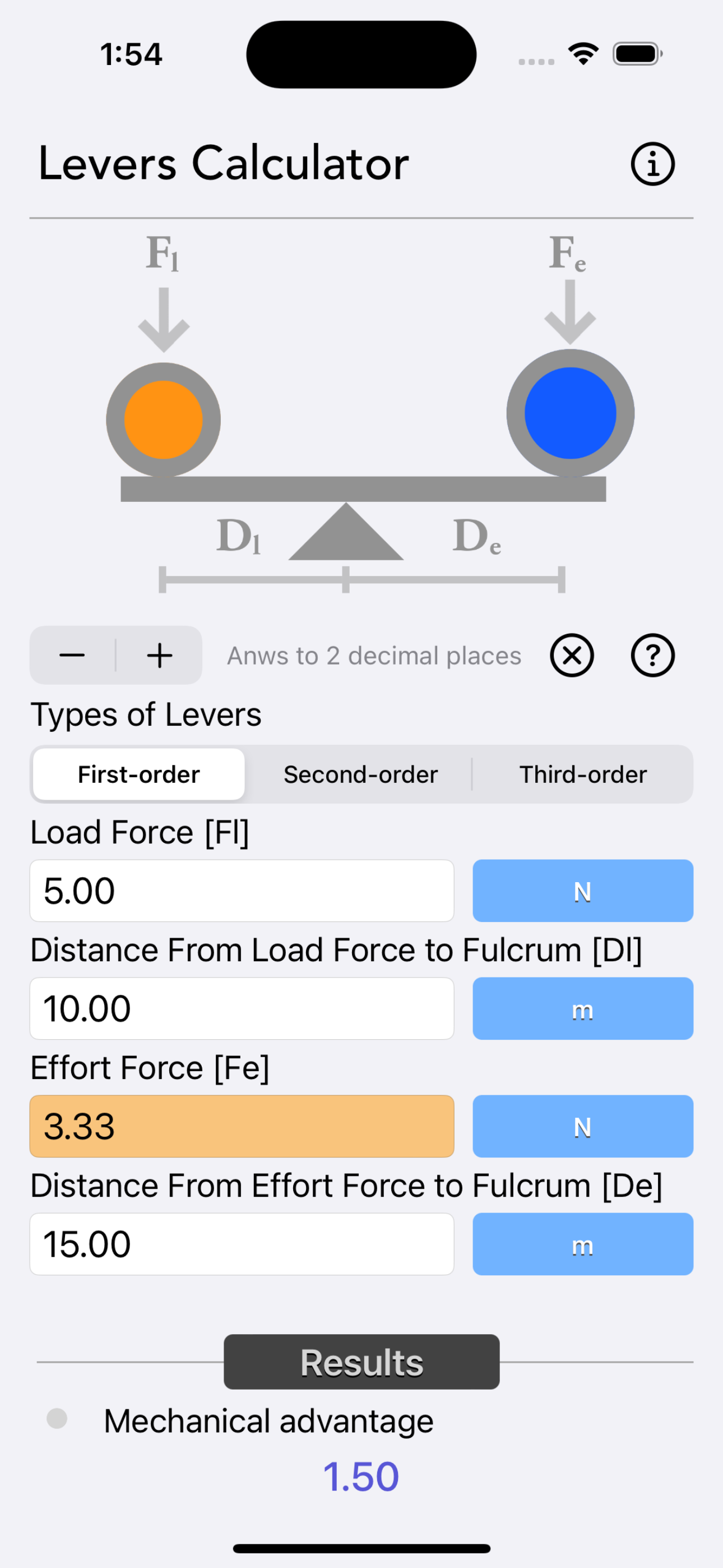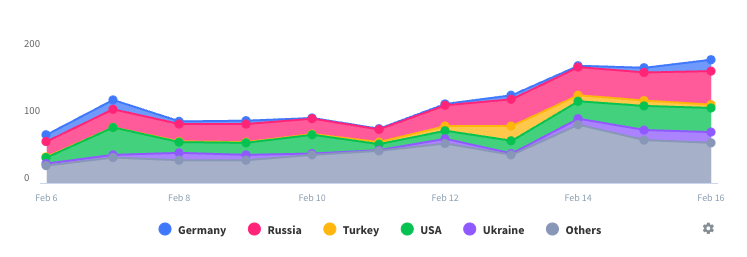
Description
The Levers Calculator is a physics/math calculator designed for quick and easy determination of effort force, load force, distance from load force to fulcrum, distance from effort force to fulcrum, or Mechanical Advantage.
Features:
- Instant calculation
- Results are copyable to other apps
- Formulas included as references
- Supports up to 16 decimal places
- Supports various units for each input
A lever is a simple machine consisting of a beam or rigid rod pivoted at a fixed hinge, or fulcrum. Classified into three types based on the location of fulcrum, load, and effort, levers amplify input force to provide a greater output force, creating leverage. The mechanical advantage of a lever is the ratio of the output force to the input force.
Classes of levers:
1. Class 1: Fulcrum in the middle - effort on one side, load on the other (e.g., seesaw, crowbar).
2. Class 2: Resistance in the middle - effort on one side, fulcrum on the other (e.g., wheelbarrow, nutcracker).
3. Class 3: Effort in the middle - load on one side, fulcrum on the other (e.g., tweezers, human mandible).
Mechanical advantage is a measure of force amplification. It's expressed by the law of the lever, where the moment action on both sides is equal:
Fe x De = Fl x Dl
Where:
- F_e = effort force (N, lb)
- F_l = load force (N, lb)
- D_l = distance from load force to fulcrum (m, ft)
- D_e = distance from effort force to fulcrum (m, ft)
The effort force can be calculated using the formula:
Fe = Fl x Dl / De
Fe = m x g x Dl / De
where
m = mass (kg)
g = acceleration of gravity (9.81 m/s²)
Thanks for your support, and please visit nitrio.com for more apps for your iOS devices.
Hide
Show More...
Features:
- Instant calculation
- Results are copyable to other apps
- Formulas included as references
- Supports up to 16 decimal places
- Supports various units for each input
A lever is a simple machine consisting of a beam or rigid rod pivoted at a fixed hinge, or fulcrum. Classified into three types based on the location of fulcrum, load, and effort, levers amplify input force to provide a greater output force, creating leverage. The mechanical advantage of a lever is the ratio of the output force to the input force.
Classes of levers:
1. Class 1: Fulcrum in the middle - effort on one side, load on the other (e.g., seesaw, crowbar).
2. Class 2: Resistance in the middle - effort on one side, fulcrum on the other (e.g., wheelbarrow, nutcracker).
3. Class 3: Effort in the middle - load on one side, fulcrum on the other (e.g., tweezers, human mandible).
Mechanical advantage is a measure of force amplification. It's expressed by the law of the lever, where the moment action on both sides is equal:
Fe x De = Fl x Dl
Where:
- F_e = effort force (N, lb)
- F_l = load force (N, lb)
- D_l = distance from load force to fulcrum (m, ft)
- D_e = distance from effort force to fulcrum (m, ft)
The effort force can be calculated using the formula:
Fe = Fl x Dl / De
Fe = m x g x Dl / De
where
m = mass (kg)
g = acceleration of gravity (9.81 m/s²)
Thanks for your support, and please visit nitrio.com for more apps for your iOS devices.
Screenshots
Levers Calculator FAQ
-
Is Levers Calculator free?
Yes, Levers Calculator is completely free and it doesn't have any in-app purchases or subscriptions.
-
Is Levers Calculator legit?
Not enough reviews to make a reliable assessment. The app needs more user feedback.
Thanks for the vote -
How much does Levers Calculator cost?
Levers Calculator is free.
-
What is Levers Calculator revenue?
To get estimated revenue of Levers Calculator app and other AppStore insights you can sign up to AppTail Mobile Analytics Platform.

User Rating
App is not rated in India yet.

Ratings History
Levers Calculator Reviews
Store Rankings

Ranking History
App Ranking History not available yet

Category Rankings
App is not ranked yet
Levers Calculator Installs
Last 30 daysLevers Calculator Revenue
Last 30 daysLevers Calculator Revenue and Downloads
Gain valuable insights into Levers Calculator performance with our analytics.
Sign up now to access downloads, revenue, and more.
Sign up now to access downloads, revenue, and more.
App Info
- Category
- Productivity
- Publisher
- Nitrio
- Languages
- English
- Recent release
- 1.2 (1 year ago )
- Released on
- Jul 28, 2018 (6 years ago )
- Also available in
- United States, Australia, Finland, Canada, China, New Zealand, Romania, Russia, Pakistan, Czechia, Philippines, Kazakhstan, Kuwait, Algeria, Japan, Portugal, Egypt, South Korea, Dominican Republic, South Africa, Denmark, Türkiye, India, Poland, Saudi Arabia, Ukraine, Colombia, France, Chile, Sweden, United Kingdom, Azerbaijan, Greece, Hong Kong SAR China, Belgium, Mexico, Ecuador, Spain, Switzerland, Vietnam, Lebanon, Austria, Israel, Ireland, Indonesia, Belarus, Malaysia, Norway, Thailand, Netherlands, Peru, Brazil, Italy
- Last Updated
- 3 months ago
This page includes copyrighted content from third parties, shared solely for commentary and research in accordance with fair use under applicable copyright laws. All trademarks, including product, service, and company names or logos, remain the property of their respective owners. Their use here falls under nominative fair use as outlined by trademark laws and does not suggest any affiliation with or endorsement by the trademark holders.










